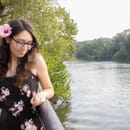Do you know what kind of research goes into coloring your clothes the different colors of the rainbow? Auburn senior, Anna Kate Osborn, is researching how companies, and even you, can naturally dye clothes to better the environment. Along with her work in the lab, she’s the president of an engineering sorority, who hopes to get more women engineers into the field.
Name: Anna Kate Osborn
Major: Polymer fiber engineering, the fiber option
Age: 21
What are your extra curricular activities? I’m the president of Alpha Omega Epsilon, an engineering sorority. I’m the vice president of Phi Psi, which is the honor society for my major. I’m in a bunch of other honor societies. I also do undergraduate research.
What do you do as the president of Alpha Omega Epsilon? I oversee all the committees, basically just day-to-day stuff. I make sure everything runs smoothly, do all the contacting, keep everyone informed on what is going on, and make sure everyone is happy.
What is Alpha Omega Epsilon’s purpose? To get women in engineering and technical sciences together, because well, if you haven’t noticed, there’s not that many. It’s nice to have a bunch of like-minded, intelligent people together that are all interested in the same thing.
Are there any stereotypes or struggles of being a woman in engineering? Yeah, well there’s really not that many girls. All the guys think that engineering is like a dude thing, but we’re a lot smarter. I’m just kidding, but it makes you work ten times harder.
How can students get involved with Alpha Omega Epsilon? You have to be an engineering major. You can’t be in a panhellenic, but you can go to AUinvolve, email me, or go to the website. Honestly, you can just go to recruitment and join.
What is the goal of your research? Natural dyeing, so finding less harsh things to put on your body and the environment, using fruits, vegetables, stuff like that. Just finding out what fabrics work best with what.
What do you do for your research? I do it with my best friend in my major, and it’s with Dr. Buschle-Diller. We started it this summer so we have a pretty good bit done so far. Basically, we extract the dye from the fruits and vegetables, then we split the dye into smaller beakers and add acid, base or salt to each one. We try a different chemical match up for each fruit, and there is always a pure dye sample so we can see what it looks like without anything added and if it would help the fabric. We use four different fabric types, and it’s really interesting to see how what works for one fabric might not work for another. Right now we’re still in like the testing phase, so after we get done testing the fruits, we’ll move on to vegetables. We have to make a website, and we basically have our own color wheel so people can click on the fruit or color they want to make and see step-by-step how to make it. It’s like a how-to for people ’cause there’s not much information out there about it.
Is the website more geared toward everyday people or large companies? Either way, honestly. A lot of the stuff we use you can buy at the store. We use some acids and bases, but we also use rubbing alcohol sometimes. It’s like kitchen chemistry. A lot of people do it at home. It’s up to you what colors you want to make. The final color varies depending on what you use to make the dye. For example, using two different amounts of an acid or base will give you different results. If you use a base, you’ll get more of a lighter color, but if you use an acid it usually strengthens the color and makes it more vibrant. What’s really interesting is when you get colors you would never expect to get. When we tested blackberries, we got grays, tans and lavender, but black beans gave us greens, blues and pinks. The only one that hasn’t given us any exciting colors is strawberries.
What are your career goals? It’s really a toss-up between protective materials, like bullet proof vests, or high performance materials for sports, but we’ll see.
What you’re doing for your research, how do you plan to tie that into your career goals? Well, honestly, I wouldn’t mind doing this for the rest of my life. There’s not many places that do all-natural dyeing for my kind of job, but I wouldn’t mind it. It’ll keep you interested, and you wouldn’t feel like you were working everyday. It’d be a fun thing to do.


